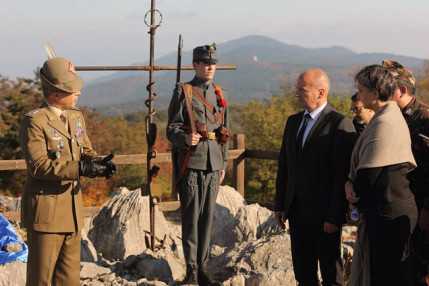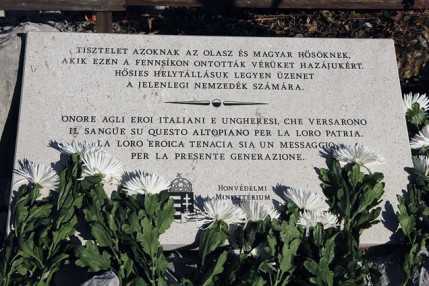Dr. István Simicskó Pays Tribute to Hungarian Soldiers Fallen in Battle of Doberdo
Szöveg: honvedelem.hu / MTI | 2016. október 28. 10:45On Thursday, 27 October at Doberdo, Italy, paying tribute to the memory of soldiers who fell in the First World War, Minister of Defence Dr. István Simicskó stated that the Isonzo Front, the Battle of Doberdo and the other battles fought there have gone down in Hungarian history forever.

He emphasized that there had never been any disputes, wars, territorial or national clashes between Hungarians and Italians, and went on saying that in spite of that, the storm of history had forced these two brave nations to take arms against each other. He stated that Hungary and Italy are now members of the same military alliance, and that this commemoration is a shining example of the ongoing effective and successful cooperation between the two nations.
In his speech, the minister also noted that a series of commemorations will continue until 2018, and that the Ministry of Defence will restore every memorial site and war grave in order to pay tribute to the fallen soldiers in this way as well. “All communities are measured by their attitude towards their dead", István Simicskó said.

Speaking on behalf of the Italian government, General Massimo Panizzi thanked Hungary for its friendly approach and emphasized that it is our obligation to remember, since the soldiers who died here have made the supreme sacrifice for a better future. “We must pass on these memories to the young generations, as the future is theirs", he pointed out.
At the end of the commemoration, on the protected historic memorial site, Dr. István Simicskó and his Italian partner marked the centenary of the end of fighting at Doberdo by unveiling a bilingual memorial tablet in joint remembrance of the fallen Italian and Hungarian soldiers. Prior to the unveiling ceremony, the minister laid wreaths at the Hungarian chapel in Visintin, consecrated in 2009, and also at the memorial pyramid of the one-time 4th Nagyvárad Royal Hungarian Infantry Regiment led by Col. Károly Kratochvil.

On Friday, Dr. István Simicskó is visiting several places in Slovenia. At the Kromberk castle, together with representatives of the country, he will commemorate the Hungarian soldier heroes killed in action on Slovenian territory during the First World War. According to plans, a joint central Slovenian–Hungarian WWI memorial will be erected at this site, under an agreement that was recently concluded between the Hungarian and Slovenian ministers of defence at an informal EU defence ministerial meeting in Bratislava.
During the First World War, the battle on the Doberdo Plateau began on 23 June 1915, as part of the fighting along the Isonzo River. The numerically superior, 850,000-strong Italian forces intended to reach the home front of the Austro-Hungarian Monarchy in the valley of the Isonzo River flowing into the Adriatic Sea. The Austro-Hungarian army, however, constructed significant defences in the steep mountains on the edge of the deep-current Isonzo. In the bloody battles of the Isonzo, the Italians made as many as 11 unsuccessful attempts in two years to cross the river and break through the front line. The battles of Doberdo took a huge toll, with 13 fallen or wounded Italian and eight Austro-Hungarian soldiers on each meter of the front line. The exact number of Hungarian soldiers killed in action at Doberdo are unknown to the present day. According to historians, a data base containing all Hungarian military losses will be completed by 2018, the centenary year marking the end of the First World War. Current estimates put the number of Hungarians killed in action during WWI at 500 to 600,000, about half of whom fell on the Italian fronts.
Photos: Captain Péter Soós (MoD IMMH)